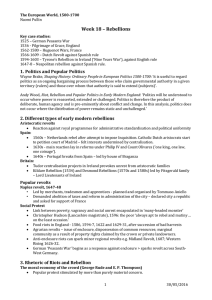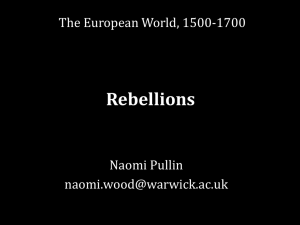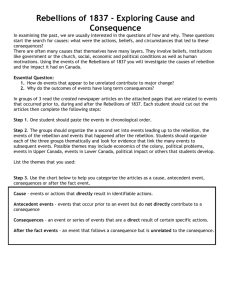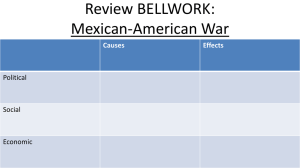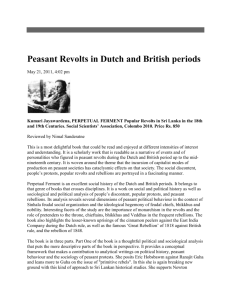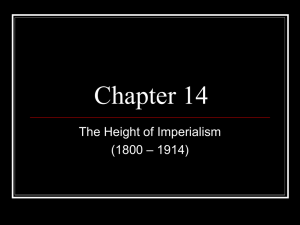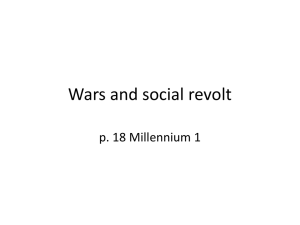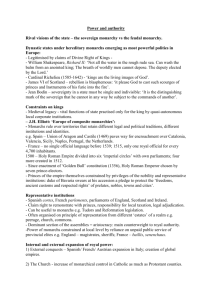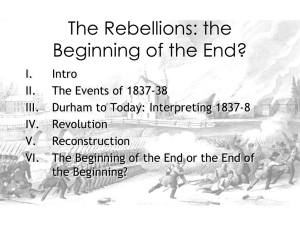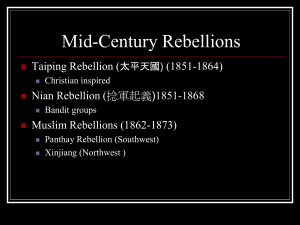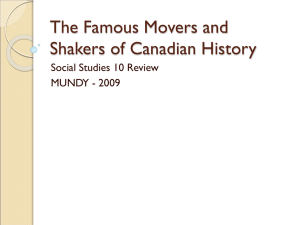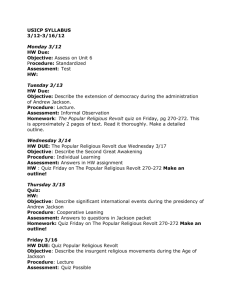European World - Rebellions Key case studies: 1536
advertisement
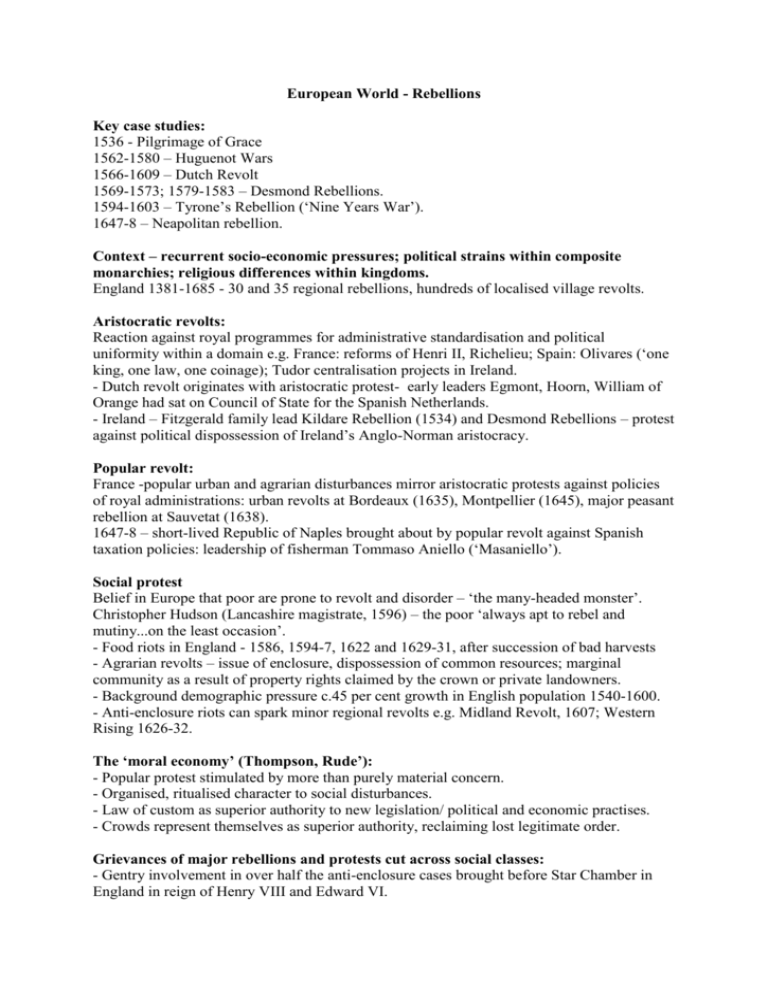
European World - Rebellions Key case studies: 1536 - Pilgrimage of Grace 1562-1580 – Huguenot Wars 1566-1609 – Dutch Revolt 1569-1573; 1579-1583 – Desmond Rebellions. 1594-1603 – Tyrone’s Rebellion (‘Nine Years War’). 1647-8 – Neapolitan rebellion. Context – recurrent socio-economic pressures; political strains within composite monarchies; religious differences within kingdoms. England 1381-1685 - 30 and 35 regional rebellions, hundreds of localised village revolts. Aristocratic revolts: Reaction against royal programmes for administrative standardisation and political uniformity within a domain e.g. France: reforms of Henri II, Richelieu; Spain: Olivares (‘one king, one law, one coinage); Tudor centralisation projects in Ireland. - Dutch revolt originates with aristocratic protest- early leaders Egmont, Hoorn, William of Orange had sat on Council of State for the Spanish Netherlands. - Ireland – Fitzgerald family lead Kildare Rebellion (1534) and Desmond Rebellions – protest against political dispossession of Ireland’s Anglo-Norman aristocracy. Popular revolt: France -popular urban and agrarian disturbances mirror aristocratic protests against policies of royal administrations: urban revolts at Bordeaux (1635), Montpellier (1645), major peasant rebellion at Sauvetat (1638). 1647-8 – short-lived Republic of Naples brought about by popular revolt against Spanish taxation policies: leadership of fisherman Tommaso Aniello (‘Masaniello’). Social protest Belief in Europe that poor are prone to revolt and disorder – ‘the many-headed monster’. Christopher Hudson (Lancashire magistrate, 1596) – the poor ‘always apt to rebel and mutiny...on the least occasion’. - Food riots in England - 1586, 1594-7, 1622 and 1629-31, after succession of bad harvests - Agrarian revolts – issue of enclosure, dispossession of common resources; marginal community as a result of property rights claimed by the crown or private landowners. - Background demographic pressure c.45 per cent growth in English population 1540-1600. - Anti-enclosure riots can spark minor regional revolts e.g. Midland Revolt, 1607; Western Rising 1626-32. The ‘moral economy’ (Thompson, Rude’): - Popular protest stimulated by more than purely material concern. - Organised, ritualised character to social disturbances. - Law of custom as superior authority to new legislation/ political and economic practises. - Crowds represent themselves as superior authority, reclaiming lost legitimate order. Grievances of major rebellions and protests cut across social classes: - Gentry involvement in over half the anti-enclosure cases brought before Star Chamber in England in reign of Henry VIII and Edward VI. - Pilgrimage of Grace – mixture of social concerns (Statute of Uses, threat of new sheep tax, effects of bad harvest, clash between Yorkshire gentry and crown officials) brought together under common opposition to crown religious policies. Conservative rebellions? - Rebellion as an act of negotiation. - Claims of allegiance – distinctions between crown and ‘evil counsellors’. - Language of reclamation, restoration of old rights, practises, customs. - But conservative rhetoric often conceals more radical reality: legitimate order is contested. Factors that can enlarge/ transform/ radicalise rebellions: 1) Support for representative institutions as a check upon the crown (Dutch revolt, Huguenot wars) – gives rise to alternative conceptions of how a kingdom should be governed. 2) Defence of the rights of a region against an imperial crown – engenders new conceptions of national identity e.g. Dutch revolt shapes mythology of a nation (anthem, the Wilhelmus); language of Irishness created in opposition to English crown policy (works of Maolmhuire O’hUghinn, Geoffrey Keating). 3) Religion and rebellions: - Influence of anticlericalism and Anabaptism on German Peasants’ War 1524-5. - Pilgrimage of Grace: banner of the Five Wounds of Christ: imagery used in Medieval crusades. - Later C16th rebellions reflect radical tendencies in Reformation/ Counter-Reformation: belief in the right of the church to command an alternative allegiance/ right of the godly to resist a heretic monarch. John Knox (Scottish Calvinist) - ‘whether obedience is to be rendered to a magistrate who enforces idolatry and condemns true religion?’ - Most transformative rebellions occur when a region possesses a religious identity separate to that of the monarch or emperor: language of militant Calvinism shapes Dutch revolt; Irish identity defined in 1570s-90s by rhetoric of the Counter-Reformation. Ideologies behind major rebellions go through different phases of radicalisation: Huguenot revolts - begin as loyal opposition to evil counsellors - 1567, constitutional opposition based on rights of laws and representative institutions - After 1572 and St Bartholomew’s Day Massacre, turn towards militant Calvinism and invocation of the rights of the people to resist a tyrant. Vindiciae Contra Tyrannos (Huguenot treatise, 1579) – people can ‘take up arms and fight against tyranny... for the sake of our religion, but also in the name of our health and homes’. Conditions that can transform rebellions into political revolutions: Crisis / division at the heart of the state, among the elites. Capacity to enlist foreign support – significance of religious division is to create bonds between rebels in one state and outside powers e.g. Spanish intervention in Ireland in 1590’ English and German support for Protestant Dutch rebels. Conclusion: Rebellions centred on competing ideas of the legitimate order; about defining one’s place in a changing political/ social/ religious world.
